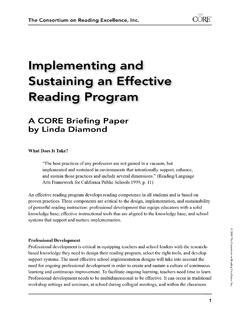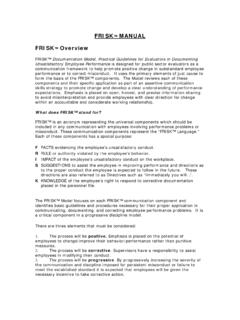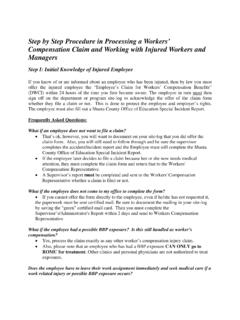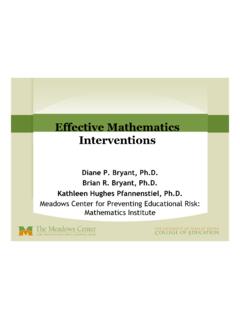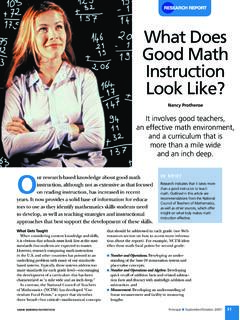Transcription of Explicit Instruction: Strategies for Meaningful Direct ...
1 Explicit Instruction: Strategies for Meaningful Direct Teaching Author: Jennifer L. Goeke ISBN-10: 0205533280 ISBN-13: 9780205533282 Publisher: Merrill / Pearson Copyright: 2009 Format: Paper; 144 pp Published: 10/13/2008 Suggested retail price: $ Description Explicit Instruction is a challenge to the view of Explicit instruction as an outdated, mechanistic instructional strategy and presents it as timely, proven, and accessible. The Explicit instruction framework is flexible and holds wide applicability for teachers across grade levels (elementary, middle, and secondary), settings (whole group, small group, general education, special education), and content areas. It provides a contemporary middle ground for teachers who may avoid traditional Direct instruction approaches, but who acknowledge that many students - particularly in today's inclusive classrooms - need instruction that is Explicit , Meaningful , and effective.
2 Although the theoretical underpinnings of Explicit instruction are presented, the primary focus is on the how of becoming an effective instructor. Readers will be able to gain expertise a by mastering small chunks of the Explicit instruction framework at a time - mirroring the process of teaching young students how to master new skills and Strategies . HIGHLIGHTS OF THIS FIRST EDITION: * Graphic organizers for each element of the Explicit instruction model provide readers easy to reference, at-a-glance information for lesson planning and implementation (Chapters 5, 6, 7) * Examples of scripted Explicit instruction lessons in each of the major content areas help readers visualize precisely what Explicit instruction looks like in practice for different content areas and grade levels.
3 (Chapter 8 & 9) * Review questions and practice activities for each element of the Explicit instruction model help readers gain competence at each discrete element of the Explicit instruction model. (Chapters 5, 6, 7) Explicit Instruction: Strategies for Meaningful Direct Teaching Author: Jennifer L. Goeke In order to create a successful Explicit instruction lesson, the teacher and students are joined in the instructional encounter; each has an important role to play in constructing learning. (p. 4) Differences between Direct Instruction and Explicit Instruction o The framework differs from [ ] because it is based on the teacher-effects literature as well as research in learning Strategies and cognitive processes. Whereas approaches focus on how presentation of material influences behavior, seeks to understand and capitalize on how incoming information is processed and organized by the learner.
4 (p. 8) Figure (p. 13) o Learning (in ) is seen as an active process that occurs within the learner and that can be directly influenced by the learner. (p. 8) o The outcome of learning (in ) depends jointly on what information is presented and how the learner processes that information. From this perspective is teacher led but with a greater emphasis on the ways in which students actively construct and process knowledge. (p. 9) o Characteristics of : It is flexible and purposeful, it promotes active engagement of all students, and it structures the learning process. (p. 14) o Table What is Explicit Instruction? (p. 10) o Table What is Explicit in Explicit Instruction? (p. 11) Four assumptions: o The way teachers think about influences the way they teach.
5 (p. 10) o A teacher s preference for certain teaching approaches should not supersede individual students instructional needs. (p. 10) o Teaching is student centered to the extent that it meets each student s instructional needs. (p. 11) o is flexible and purposeful. (p. 11) The importance of active student engagement o The degree of student learning that occurs is directly related to the time a student is actively engaged in the learning process. (p. 5) o A key consideration in the effectiveness of an lesson is the incorporation of student learning Strategies that actively engage students in the construction of their own learning are a distinguishing feature of high-quality (p. 12) Use of Assessment in o Frequent and accurate assessment is required to distinguish between acquisition and mastery An acquisition problem indicates that a student has not learned a particular skill (strategy, content concept, or procedure) and must be explicitly Mastery problems indicate that the student has learned the concept, skill, or procedure; however, learning has not reached the point of automaticity where performance is not only accurate but also fast, smooth, and without hesitancy.
6 (p. 20) For acquisition problems, early identification and intervention are required. The focus is on teaching students what they have not learned, often through Once the needed concept or skill has been learned, adequate practice is provided so that mastery can be achieved. (p. 20) Mastery problems require an Explicit review of what has been learned, followed by practice of the concept, skill, or procedure until mastery is clearly and definitively reached. (p. 20) o Comparisons are made between the purposes for Curriculum-based assessments, classroom assessments, large-scale assessments and alternative proficiency assessments (Table p. 21) Planning for - Writing Learning Objectives o If you don t know what you want students to learn, it is difficult to select an appropriate means to get there.
7 (p. 25) o An objective describes an intended outcome of instruction rather than the process of instruction itself. (p. 25) When Is Appropriate? o When the goal is teaching a well-defined body of information or skills that all students must master o When assessment data indicate that students have not acquired fundamental skills, Strategies , and content o When assessment data indicate that student progress toward mastery of skills, Strategies , or content needs to be accelerated o When inquiry-oriented or discussion-based instructional approaches have failed. (p. 28) The Teacher s Role o The science of Explicit instruction involves the events of instruction and Strategies for engaging the learner. The art comes into play in how the lesson is delivered. (p. 29) o A teaching style that incorporates teacher presentation variables can provide the necessary excitement and encouragement to motivate students to succeed.
8 (p. 30) [Figure p. 31] o Teachers must provide ways for students to actively and overtly demonstrate their learning by posing and answering questions, manipulating new information, and relating it to what they already know. (p. 39) o Table Active Participation Strategies o For any new skill or strategy taught (or a skill or strategy that students are having difficulty mastering), the teacher should consider whether a prompt might be useful. (p. 42) [ Prompts are concrete, skill-specific references on which students can rely for support until they become independent. p. 42] o Throughout , teacher monitoring of student understanding is critical. Monitoring understanding allows the teacher to observe students performance to make sure they exhibit the skills necessary to complete the instructional objective.
9 It also allows the teacher to keep student engagement high by determining if it is appropriate to proceed; if more practice or elaboration is needed; if the skill, strategy, or concept should be retaught; or if it is appropriate to abandon instruction and return to it at a later Monitoring student understanding involves two complementary skills: checking understanding providing corrective feedback. (p. 43-44) The Learner s Role o For teacher presentations to be effective, students must be encouraged to provide the second, complementary half of the transaction: active engagement. An optimal lesson involves an effective, dynamic teacher and an active, engaged learner. (p. 37) o Learning is an active process during which students create meaning by connecting new skills, Strategies , and concepts to prior knowledge and ideas.
10 (p. 37) o Active engagement is not something that all student naturally do; rather, it is a mental state that skillful teachers create in their students. Students participate actively when they do the following: Try to understand and make sense of new materials Relate ideas and information to prior knowledge and experience Use organizing tools or principles to integrate ideas Relate supporting details and evidence to conclusions Look for principles or patterns (p. 39) Components of an Lesson o Preinstructional Set (anticipatory set) Three Components: Gain students attention [Figure p. 51] Inform students of the learning objectives [Figure p. 54] Use informed instruction [Figure p. 57] Four Purposes: It is intended to focus student attention on the lesson It creates a cognitive framework for organizing the skills, Strategies , or concepts to follow It can extend understanding and application of new ideas It can stimulate student interest and involvement in the lesson o Preparing the Knowledge Base for Instruction 3 Strategies that cognitively prepare students for instruction (not to be used all within the same lesson): Activate prior knowledge most useful for expanding students knowledge of a particular content area or concept, beneficial when beginning a new unit or topic of study [Figure p.]
